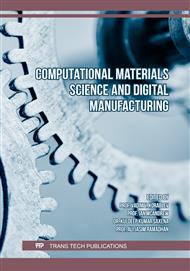p.51
p.61
p.69
p.77
p.83
p.89
p.99
p.109
p.117
Modeling the Specific Heat Capacity of Chemical Elements Superalloys of Gas Turbines
Abstract:
One of the thermophysical characteristics of metals and alloys is the specific heat capacity. It is measured, as a rule, experimentally, which determines the high cost and labor intensity of this approach. A model has been developed for calculating the specific heat capacity of chemical elements and their compounds. The calculation results are in satisfactory agreement with the experimental data of other authors (reference data). The simulation results are used to calculate the thermal state of gas turbine parts. It can also be used in alloy design.
Info:
Periodical:
Pages:
83-87
Citation:
Online since:
April 2023
Authors:
Price:
Сopyright:
© 2023 Trans Tech Publications Ltd. All Rights Reserved
Share:
Citation:


